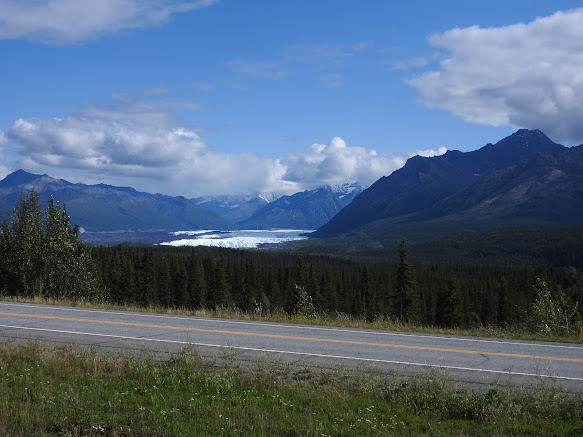August 13-15 - Wrangell St. Elias National Park - the largest national park!
Alaska in August has been rainy with limited sunshine. Susan was able to get an extra day off (I've been working 4 days on, 3 days off for a month), so we chose to take the 6 hour drive to the largest national park in the United States - Wrangell-St. Elias in the southeastern corner of Alaska. Our 3 days off turned out to be spectacular, with lots of sunshine! We did a flightseeing tour of glaciers in the Chugach Mountains. The Wrangell Mountains were socked in, so Chugach was a great alternative.
To break up the trip, we decided to make some scenic stops along the way and also check out the Museum of Alaska Transportation and Industry in Wasilla, about halfway to Wrangell. This museum is full of planes, trains, and automobiles. I loved it and Susan enjoyed it as well.Snowmachine with a steering wheel. Snow toboggan!
In Alaska, these are called snow machines, not snowmobiles. So when you visit Alaska and want to sound like a local, ask about getting around on their snow machine. This is an oldie but goodie.Of course, any good transportation museum would have fire trucks. These are some older models, and they had several newer aerial trucks (what I always called hook and ladder trucks) as well.
In Yellowstone, I drove the White Touring Cars (aka Yellow Bus) on tours. When I was a youngster, I always loved this model of White flatnose truck, with the sleek curve to the front. White was purchased by Freightliner, and eventually the White name was removed completely. But these cabover models have always been my favorites. Both have seen better days, but neat to see up close.
Of course, the Alaska Railroad has to make an appearance. This locomotive was the first model purchased by the ARR when they moved from steam engines to diesel. Cute window characters.
And this old Nash looks like it just drove off the movie set from CARS.
Susan finally wrangled me away from all the cars and trucks so we could get on the road to Wrangell-St. Elias. But we did make a stop at the Dairy Queen in Wasilla for lunch! Mint Oreo Blizzard!
As we drove east on the Glenn Highway from Palmer to Glennallen, the awesome Chugach Mountains appeared on our right. There were several great turnouts where was could see glaciers carving out of the mountains. We didn't know we'd see these again...this time from the air...tomorrow.
These glaciers feed the Matanuska River, which creates another valley with the Susitna River. Therefore these 2 huge valleys are called the Mat-Su valley. This area of Alaska was part of a social experiment by the federal government during the Great Depression. Farmers from the Midwest (principally Minnesota, Wisconsin, and Michigan since they were already accustomed to cold weather) were resettled to the Mat-Su valley. (If you're interested in more information about this resettlement program and Alaska, click this link and start reading on page 13.) About 200 families came to the Mat-Su Colony as part of the New Deal resettlement, but some started returning home almost immediately because the farming in Alaska was so much harder. Of that original group, about 20 are still in the Mat-Su Valley. The city of Palmer is in the heart of the valley, and we're going to the State Fair there in a couple of weeks. Because of the extended periods of sunlight during the spring and summer, crops grow to huge sizes. Can't wait to see those! In the meantime, we hit the road and got some great views of the Chugach.

River of ice. Sun shining bright on this glacier.
Once airborne, the ruggedness of the Chugach Mountains was overwhelming.
And glaciers everywhere. The Chugach Mountains were created by tectonic plate action, while the Wrangell Mountains were created by volcanic activity. In fact, steam rises from Mount Wrangell today! Meanwhile in the Chugach Range, the uplift of the tectonic plates has allowed the glaciers to form and move down to the Gulf of Alaska. These rivers of ice are massive but they have been impacted by climate change, shrinking considerably.
We finally reach our cruising altitude of 8500', and we were surrounded by mountains and glaciers.
One of the most interesting things I learned was the term jokuhlaup (yo-KOOL-laup), It is an Icelandic term for a glacial lake (i.e., full of water) dammed up by the ice that suddenly drained, leaving behind huge blocks of glacial ice. This NPS link is a great explanation of jokuhlaup, and this is what it looks like. Our pilot estimated that ice face at 150' on the right side to 300' on the left. HUGE!
As the glacier calves, huge chunks of ice float in the water.As we returned to the airstrip and dropped in altitude, the fireweed on the hillside exploded in color below us.
The Chugach Mountains are 250 miles long, 60 miles wide and the high point is Mount Marcus Baker at 13,176'. Basically they range from Anchorage to Valdez across southern Alaska. Like so much in this amazing state, they are immense!































Comments
Post a Comment